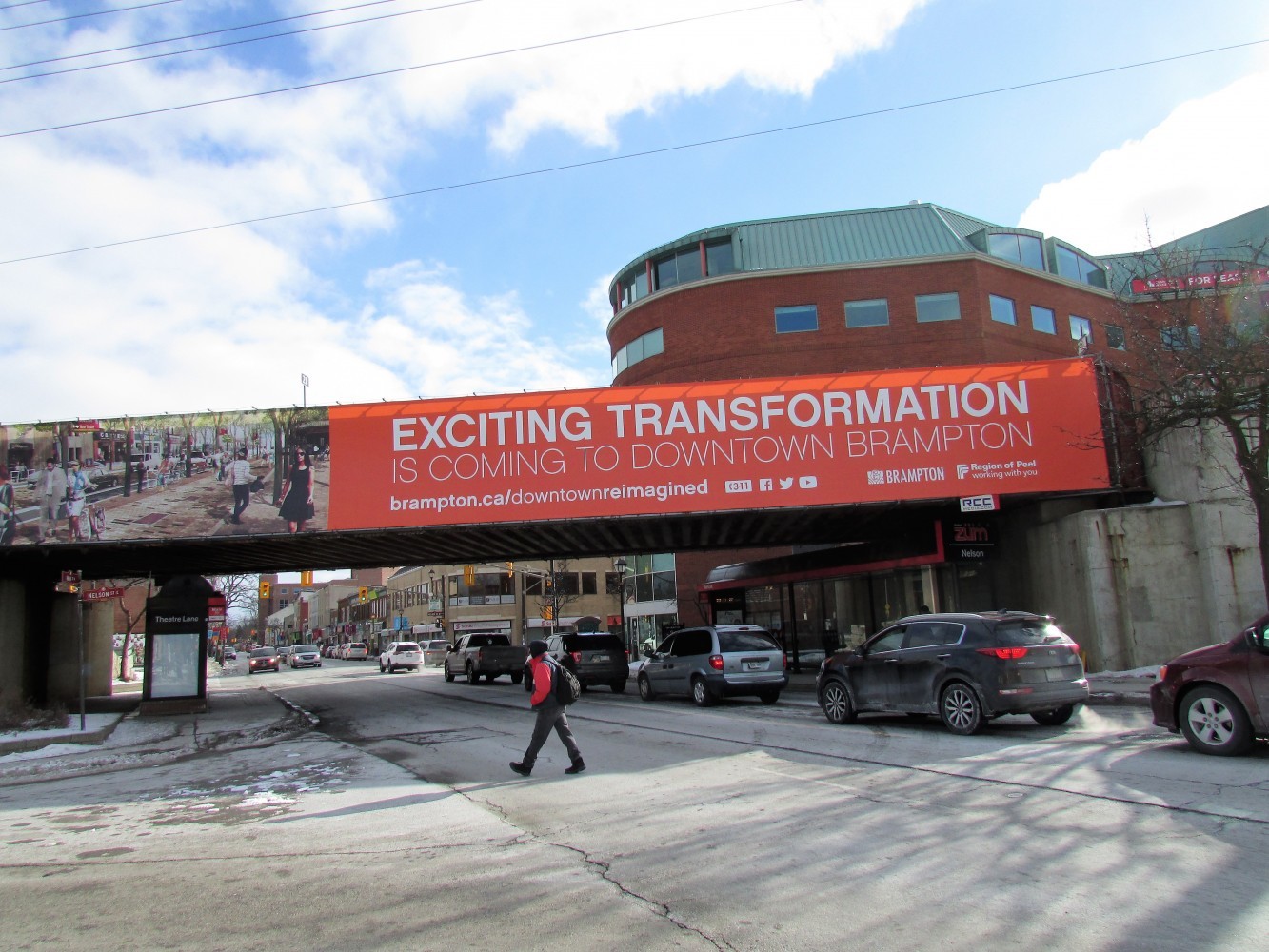
‘High risk’ aging downtown infrastructure in Brampton will get temporary help from Regional plan but LRT could change everything
In December of 2017, a pipe burst in downtown Brampton and left a muddy mess. Local businesses had to temporarily close and a residential building on George Street was evacuated.
It was one of many signs that the city centre is in desperate need of a major upgrade, as dangerous risks have been neglected by local leaders for decades.
A year later, the City of Brampton put its transformative Downtown Reimagined Plan, to finally address forsaken infrastructure and revitalize the decaying area, on the backburner, despite a broad marketing campaign that hailed the project as the catalyst for future dynamic downtown redevelopment.
Part of the project focused on replacing regional water and sewer lines below street level, and its delay raised concerns that incidents like the one in 2017 would become even more common. The cancellation of the massive project at the city level forced the region to forgo its plans as well.
Now, temporary infrastructure work led by the Region of Peel will provide protection from the “high risk” associated with aging downtown infrastructure, a recent report states. “The Region has experienced a high number of breaks in the downtown area since 2006, particularly along Queen street,” a spokesperson for the Region told The Pointer. “The Region believes additional breaks may occur in the future.” While most of the breaks have been minor, larger breaks could result in flooding, which could devastate businesses in the downtown area.
Staff and Mayor Patrick Brown cited unknown underground water channels and the need to investigate their potential impact, as the official reason for the cancellation of Downtown Reimagined, until work could determine how to move forward. Little has been said since, and speculation has swirled that the high cost of the project is a factor behind its shelving. Bids came in at almost triple the original estimate, which had already increased to roughly $33 million. One of the companies hoping to do the work said it would cost $73 million, and that was two years ago. But Brown was aggressively pushing a tax freeze he promised during the 2018 election and shortly after, the project was kicked down the road.
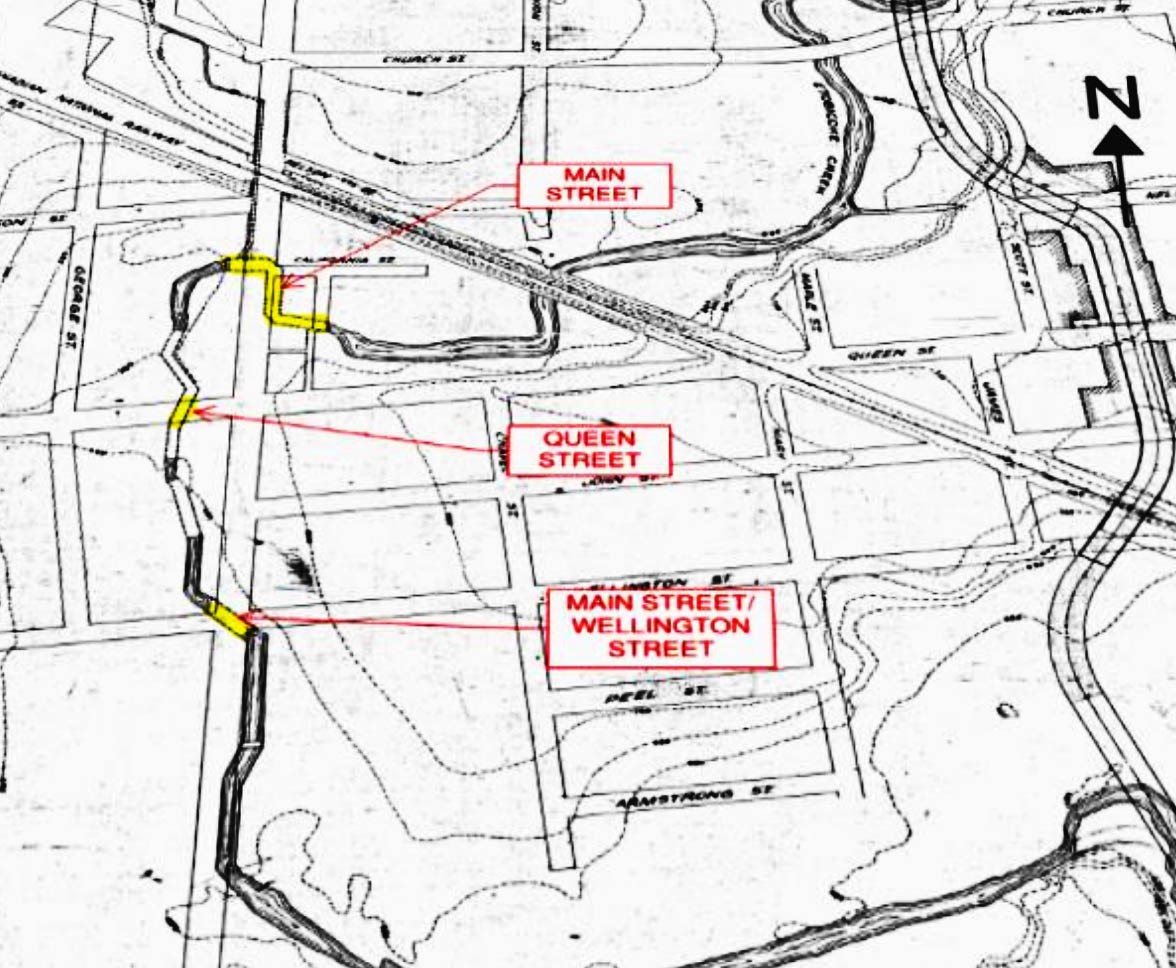
The City of Brampton partially blamed underground concrete water channels for delaying Downtown Reimagined work.
Meanwhile, the aging downtown infrastructure gets older by the day and the surrounding streetscape becomes more and more irrelevant, with storefronts boarded up, buildings demolished and retail outlets now struggling to stay afloat during the pandemic.
The region wants to put a temporary bandage on the crumbling water and wastewater infrastructure in the downtown core. In an approved report presented to Regional Council Thursday, staff planned for interim road, water, and wastewater work to take place. Water and wastewater work falls under the responsibility of the region and roads are the responsibility of the city.
The interim phase is a stand in for the first phase of the region’s broader plan to replace and upgrade infrastructure to aid the future growth of the downtown area.
There are four phases in total. Phase one focuses on the water main on Queen Street from Mill Street South to Scott Street and on Main Street from Nelson Street to John Street. Water mains for the former area were installed between 1969 and 1970 and the latter was installed in 1995, Amie Miles, a spokesperson for the Region of Peel, told The Pointer.
The original plan for phase one was put on hold as the City continues to discuss project plans for the area, including the LRT. The planning for the other three phases continues. The aim is to serve the long-term growth of the downtown core, Miles said. This will be the first time any of the infrastructure will be replaced.
The second phase is looking at the water main on Queen Street from McLaughlin Road South to Mill Street South, with construction starting in 2021. The original infrastructure was installed in 1972. Phase three focuses on the environmental assessment for the water main on Centre Street. The water main was installed sometime between 1967 and1972. Its construction is set to start in 2021. Phase four focuses on work northwest of the downtown core, but the design has not been completed at this time.
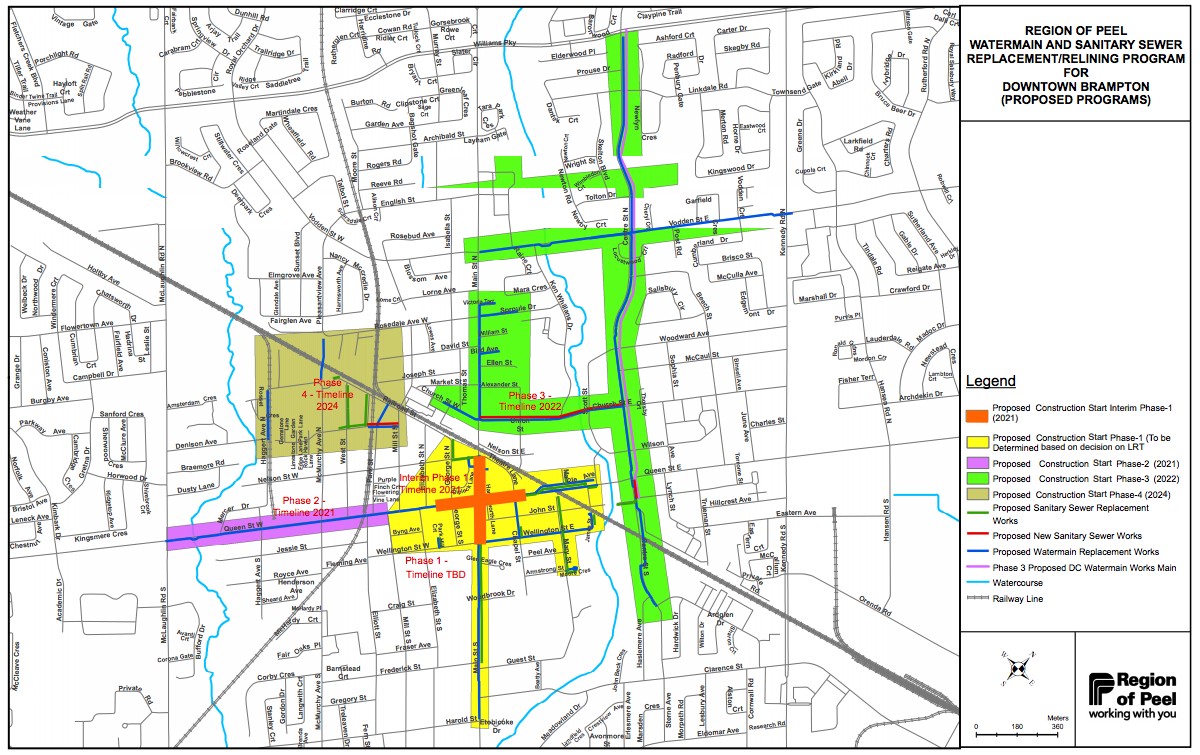
The extensive infrastructure work needed in downtown Brampton is planned to be completed by the Region of Peel over the next several years.
Upgrades to the infrastructure depend on the material, age and condition it’s in, with older metallic water mains having a lifespan of 40 to 60 years and newer plastic water mains 80 to 100 years, Maria Andersen, a spokesperson for The Region of Peel told The Pointer.
The temporary plan will cost the region upwards of $7 million. Many buildings that are in the right of way will need to be considered during the extensive work. “Also, the Right Of Way is very small and narrow so increased cost is experienced due to having to manage traffic during construction,” Miles said, adding the proposed amount is far below what such a project would normally cost. Full replacement is estimated to come at a price upwards of $20 million.
Brampton will need to put down $550,000 to pay for the road work. Regional Councillor Martin Medeiros (Wards 3 and 4) said a report will be presented to council in the coming weeks.
With the project approved at the regional council meeting, the design process will start immediately, Miles said, and construction is anticipated to start in 2021. The design will take 12 months to complete and 18-24 months for construction.
The report states that if a decision by Brampton Council on the LRT (to choose between a tunnel option and different surface alignments along Main Street) comes before the interim project starts, staff will review how the temporary project will be completed. If an option for the LRT is approved, all of the temporary work will be overhauled, with a new design to deal with gas and hydro lines, and other factors. The report labels this as “economic throw away.”
Realistically, with the need for downtown flood mitigation and the massive infrastructure needed to mitigate risk posed by Etobicoke Creek, it could be more than a decade before the LRT construction begins, and that’s if the province signs off, and the City finds funding partners. The tunnel option could cost $1.7 billion and currently not a cent has been secured or even committed for the higher order transit line into downtown.
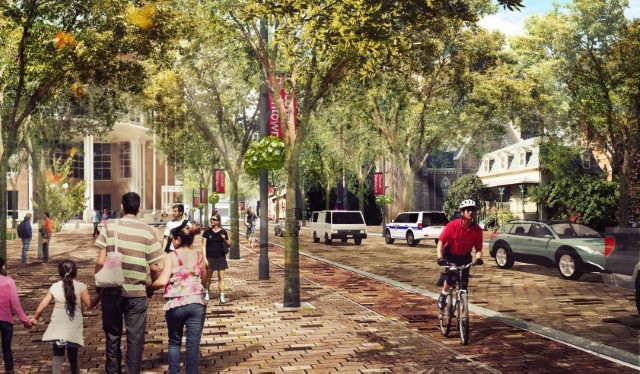
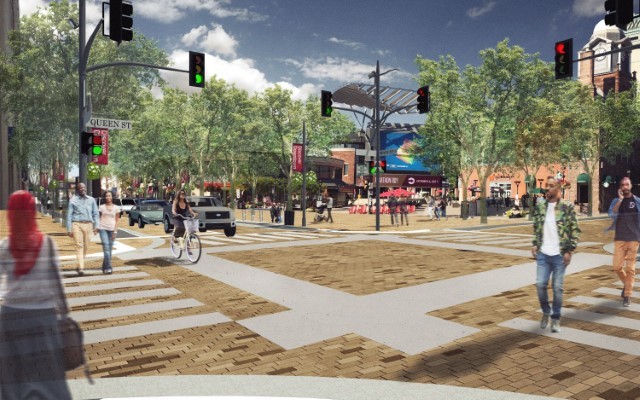
The Downtown Reimagined project plans to revamp Brampton's downtown streetscape.
Miles said construction for the LRT (if it gets approved and the money is found) is not expected to happen for a number of years. “Risk associated with delay of the interim utility work” is not something staff want to take a chance with.
If the LRT does move forward, the Region will then have to determine what infrastructure needs to be redone.
It originally stated in 2011 the infrastructure needed to be replaced or upgraded and a plan was created with the City of Brampton’s Downtown Reimagined plan in mind. But in December of 2018, right after Brown was elected, the City backed out of the agreement saying the winning bid for the project, set at almost $56 million, was too high as the new mayor wanted a tax freeze. Regional Council scrapped its original plan in January of 2019, stating without financial assistance from Brampton, it couldn't go through with the project.
The challenges listed in the report on the temporary option far outweigh many of the benefits. But with Brampton Council’s continued irresponsibility, passing tax freezes at the expense of desperately needed work, creating a “high risk” situation for downtown infrastructure, the Region is between a rock and a hard place.
Money for the temporary project could essentially be thrown away if the LRT is constructed, while concerns over business disruptions in the wake of the already debilitating pandemic include the loss of street parking, barriers to pedestrian traffic and the possibility of construction delays.
Medeiros said the plan needs to move forward as the work is long overdue. Businesses have been looking for improvements, he told The Pointer. But he understands some may be at their wits end because of the back and forth that has gone on with improvements to the downtown core, as well as the impacts from the spread of the novel coronavirus.
The high risk posed by the old infrastructure could lead to massive losses and insurance headaches, especially if a catastrophic break should occur.
Meanwhile, discussion on the LRT is ongoing. Options include the tunnel versus a surface design and a loop option close to the downtown core. The decision won’t come before 2021. Despite everything that hangs on the LRT decision, a recent report from city staff on the matter did not provide any updated information on financial details or how the Etobicoke Creek downtown flood plain issue will be mitigated.
The Toronto and Region Conservation Authority recently completed its environmental assessment for the floodplain with a plan to protect the downtown area, but it stated the City’s LRT plan had nothing to do with its work and the City has not indicated if it plans to adopt TRCA’s proposal, which could cost hundreds of millions of dollars that Brampton would have to come up with.
It’s unclear how the City can move forward with any LRT plan before it decides on and funds downtown flood mitigation infrastructure that has also been neglected for decades and has prevented the city centre from being revitalized.
An LRT open house hosted by the City is currently taking place and will conclude July 31.
Email: [email protected]
Twitter: @nida_zafar
Tel: 416 890-7643
Submit a correction about this story


